
Text by Nicole Bouglouan
Photographers:
Roger Ahlman
Pbase Galleries Peru and Ecuador
John Anderson
John Anderson Photo Galleries
Steve Garvie
RAINBIRDER Photo galleries
Tom Grey
Tom Grey's Bird Pictures
Tom Merigan
Tom Merigan’s Photo Galleries
Otto Plantema
Trips around the world
Ingo Waschkies
My bird pictures on Pbase
Nicole Bouglouan
PHOTOGRAPHIC RAMBLE
Sources:
HANDBOOK OF THE BIRDS OF THE WORLD vol 1 by Josep del Hoyo-Andrew Elliot-Jordi Sargatal - Lynx Edicions - ISBN: 8487334105
THE HANDBOOK OF BIRD IDENTIFICATION FOR EUROPE AND THE WESTERN PALEARCTIC by Mark Beaman, Steve Madge - C. Helm - ISBN: 0713639601
L’ENCYCLOPEDIE MONDIALE DES OISEAUX - Dr Christopher M. Perrins - BORDAS - ISBN: 2040185607
CREAGUS@Monterey Bay (Don Roberson)
Wikipedia, the free encyclopaedia
Bird Web (Seattle Audubon Society)
What Bird-The ultimate Bird Guide (Mitchell Waite)
GAVIIDAE FAMILY
ORDER GAVIIFORMES
Divers or Loons - Genus Gavia
Loons or Divers are elegant waterbirds perfectly designed for diving. This small family contains five species very similar in most aspects such as appearance, diet and feeding habits, breeding behaviour and movements.
They are well known for their voice, and especially their characteristic yodel call, a haunting sound heard over the tundra. Males and some females utter this call to proclaim the occupation of the territory.
Human disturbances are responsible for most breeding failures, but fishing nets and oil pollution affect these birds too. However, they are not currently threatened, but their future will depend on water quality, increase of disturbances and chemical pollution of both inland and coastal waters where they find their favourite preys.
Protection measures are active to maintain the numbers, and some populations have recovered very well.
They are named “loon” in North America, and “diver” in UK and Ireland. They are found in most parts of Northern North America and Northern Eurasia and migrate southwards after breeding.

Loons or Divers are fairly large birds with a length ranging between 53 and 90 centimetres, and a weight of 1000 to 6400 grams. They are long-necked, low-bodied diving birds. Both sexes have similar plumage, but the female is slightly smaller than the male.
In breeding plumage, they have silvery-grey head and neck with black or red patch on foreneck, or black head and neck, with black and white stripped pattern on neck sides, nape or throat.
The underparts are white, whereas the upperparts are uniformly dark brown in Red-throated Diver or Loon, and chequered black and white in the four other species.
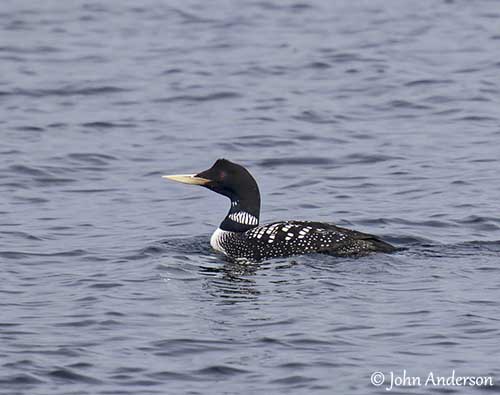
or Yellow-billed Loon
The dagger-like bill can be dark grey to blackish, or ivory-white in White-billed Diver or Loon. The eyes are deep red in adults, brighter during the breeding season. The short, strong legs with laterally compressed tarsi and the webbed feet are well-adapted for propulsion underwater. However, these elegant birds appear very clumsy on land.
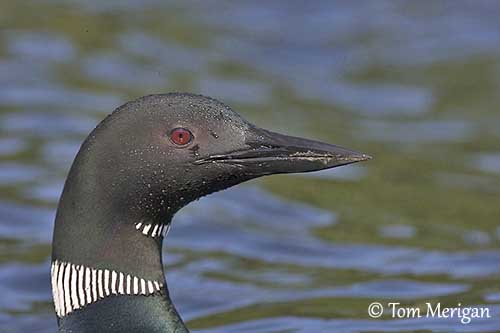
or Common Loon
The winter plumage is much duller with uniform brown-grey upperparts. The pattern on head and neck is lacking, and the underparts are white, contrasting with the darker neck and back.
The juvenile resembles non-breeding adult, and the dorsal feathers are usually edged pale buff. The eyes are dark brown.
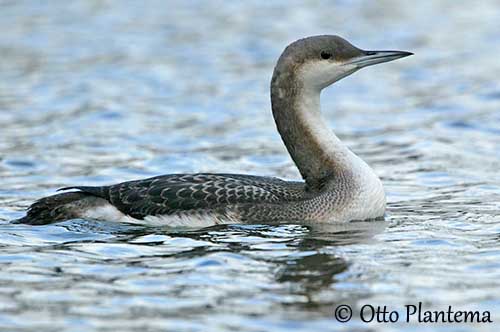
or Arctic Loon

Loons or Divers are aquatic birds. They breed on freshwater lakes or large ponds in tundra, in subarctic and boreal areas. They usually nest in remote sites, from estuaries to deep lakes or small pools, and sometimes on sheltered coasts. They feed mainly on their breeding lakes, or in the vicinity of these areas.
During winter, they avoid the often frozen inland waters and can be found on rocky coasts like the Great Northern Diver or Loon, whereas other species frequent sheltered shallow coastal waters and can be seen in bays.
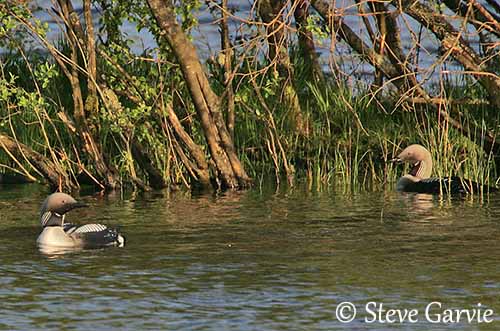
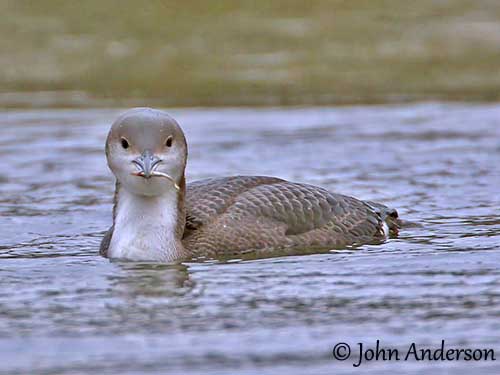
or Arctic Loon
They find their preys underwater, between two and ten metres depth. They feed primarily on fish, but they also take frogs, crustaceans, molluscs and fish spawn, and occasionally plant matter. They hunt by sight, and favour the clear waters where they can easily find preys.
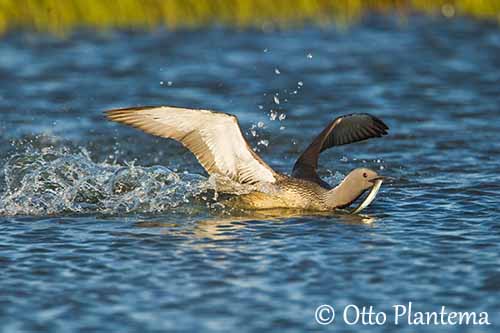
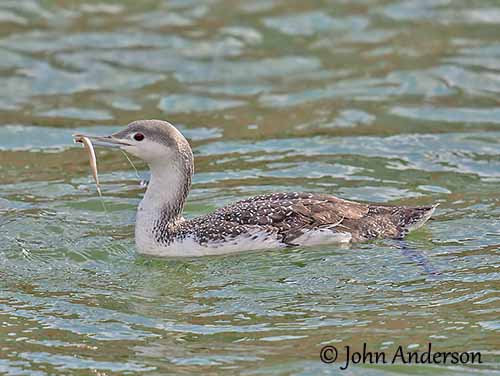
Winter
They dive by slipping gently below the surface and pursue the prey underwater, propelled by their webbed feet. The dagger-like bill is used for stabbing or grasping the food which is often swallowed before the bird surfaces. However, the larger or spiny fish are carried out of water before to be eaten.

They may form large flocks after the breeding season, and up to several hundred birds can gather at abundant food sources. In the same way, they roost together on the water at these localities.
They spend long time in plumage care and frequently bathe with vigorous wing-shaking, rolling and diving.
or Common Loon
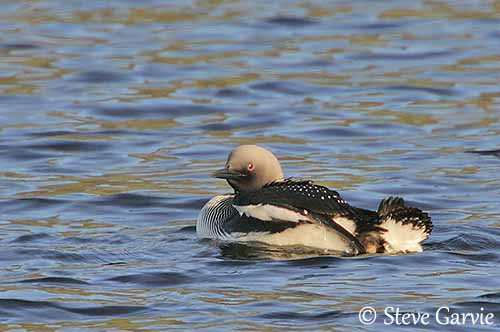
or Arctic Loon

or Arctic Loon
Loons or Divers are monogamous with long-term pair-bonds, usually for life. They return to the same territory and nest-site year after year. The breeding season starts in May-June in the southernmost breeding range and continues through the summer.

or Common Loon
The established pairs remain together during winter, and nest fairly soon after some short displays.
The new pairs perform simple courtship displays involving synchronized movements such as “bill-dipping”, “splash-diving” and “rushing” underwater prior to copulation which occurs on land and frequently, until all the eggs are laid.
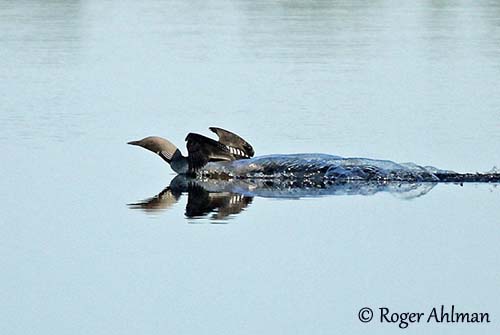
or Arctic Loon
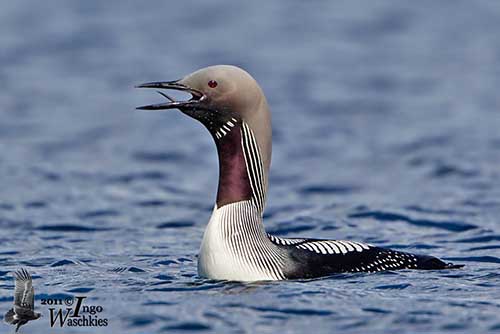
or Arctic Loon
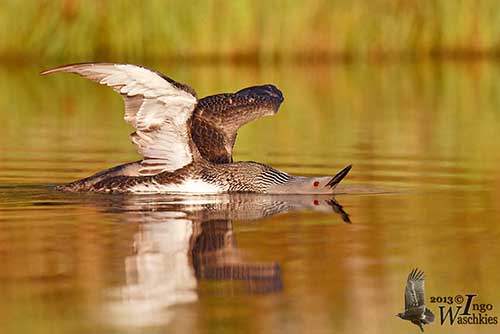
Loons or Divers can be territorial if other adults occur within their field of vision. They perform threat displays, raising the neck in order to expose the throat patch and the neck pattern. These displays are fairly similar to the courtship displays and usually end in chases over water with the wings flapping strongly. However, fights are not very frequent, but they can be intense and violent because the birds use bill and wings. One of the birds, sometimes both, may die during these aggressive encounters.

or Arctic Loon
Courtship and threat displays are accompanied by calls. The typical yodel call is a haunting far-carrying sound “a-a-whoo-kwee-wheeooo-kwee-wheeooo”. This long call is given by the birds to proclaim the occupation of the territory, a low-pitched whistle interspersed with some clear notes. It is usually given by males, but in the Red-throated Diver or Loon, both mates produce this type of call.
A long wailing call is also used to proclaim the territory, shorter and intense in the Black-throated Diver or Loon “kluiee-ku-kluiee-ku-kluiee-ku-kluiee”.
Both species give croaking calls of warning, whereas the Great Northern Diver or Loon and the White-billed Diver or Loon produce a strident tremulous scream resembling manic laughter.
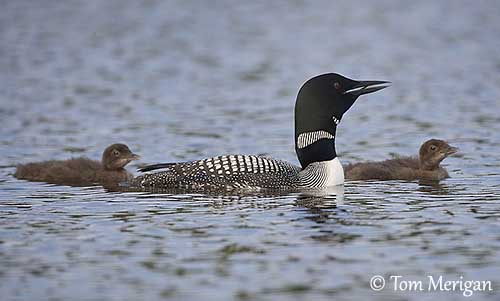
or Common Loon
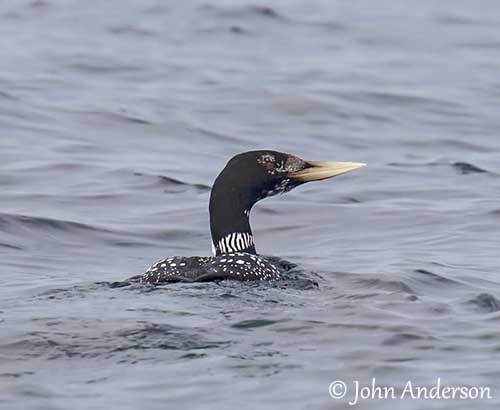
or Yellow-billed Loon
The Pacific Loon or Diver is usually silent in winter. But during the breeding season, it utters repetitive, hoarse croak “kok-kok-kok-kok” and deep barking calls “kwow”.
During copulation and between adults and chicks, some low-pitched moaning sounds are uttered.
The Red-throated Diver or Loon utters a frequent goose-like cackle when flying over its territory and the surrounding area “gwuk-gwuk-gwuk-gwuk”.
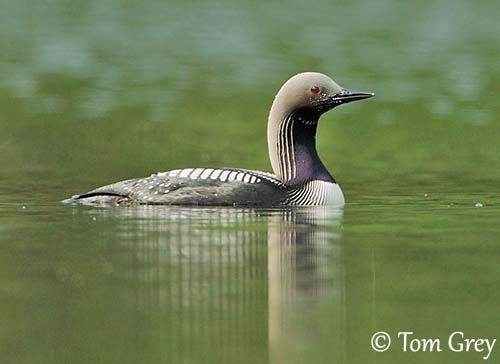
or Pacific Diver
The male usually selects the nest-site, often on small islands and islets, but also stretches of shallow water close to wide open water expanse for easier escape. The nest-site is always near water, often within one metre from the shore, because loons or divers are very clumsy on land. But such location may involve the destruction of the nest by flooding, due to alterations of water levels.
The nest is very simple, a pile of plant matter such as moss and aquatic weeds forming a shallow central depression on the ground. The male brings most of material, and fresh materials are often added during the incubation by the incubating bird. The nest of the Great Northern Diver or Loon is usually concealed among vegetation.
They usually are solitary nesters, but several pairs of Red-throated Diver or Loon may breed semi-colonially and defend only a small area around the nest. Some territorial behaviour can be observed on their feeding areas too.

The females lay 1-3 (usually 2) large olive-brown eggs with darker spots, at intervals of one to four days, sometimes up to eight days. They rear only one brood per season, although a smaller clutch can be laid is the first is lost in a flooded nest.
Both adults incubate, but mainly the female, starting with the first egg laid. This period lasts about four weeks. The chicks hatch asynchronously and if the food is scarce, the larger chick feeds more than the smaller one which dies by starving.
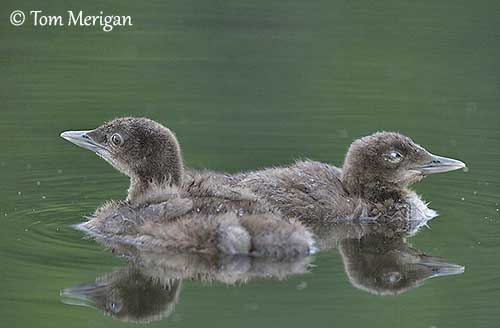
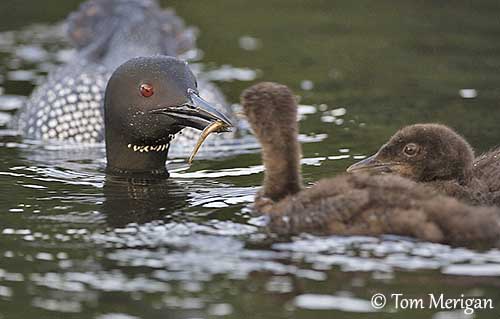
or Common Loon
They are able to leave the nest and to swim very soon after hatching, but they are still brooded on dry land for the first days. Two or three weeks later, they definitively leave the nest and can follow their parents, swimming or riding on adult’s backs. They are fed by adults until they are fully grown. According to the species, they fledge between seven and nine weeks after hatching. Parents continue to feed them irregularly for long time. They can breed at 2-3 years old.
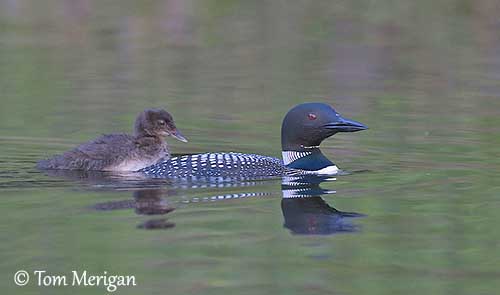
or Common Loon
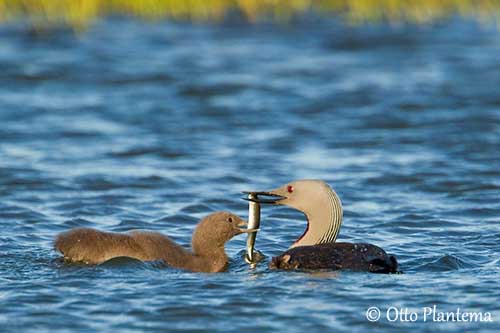
From several studies, the breeding success is rather low due the “rest years” taken by the established pairs which only breed in three out of every four years.
Nest failures are also due to natural causes such as infertile eggs, destruction of the nest by flooding, or predation of chicks and eggs by skuas, gulls, cranes, sea eagles, racoons and mustelids and also large fish.
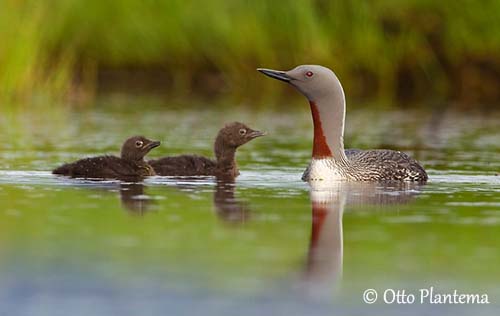
Loons or Divers are migratory, and some of them can travel very long distances to find ice-free waters. They usually move southwards and seawards after breeding. They leave their breeding grounds in Alaska, Canada and Greenland, but also NE Russia to reach Baja California, Japan and Korea. Some populations may stop off in Great lakes such as the Great Northern Diver or Loon, whereas the Red-throated Diver or Loon and the Black-throated Diver or Loon also winter in Black, Caspian and Mediterranean Seas. The Siberian populations have to fly long distances over land and they probably follow the major rivers to reach their wintering areas.
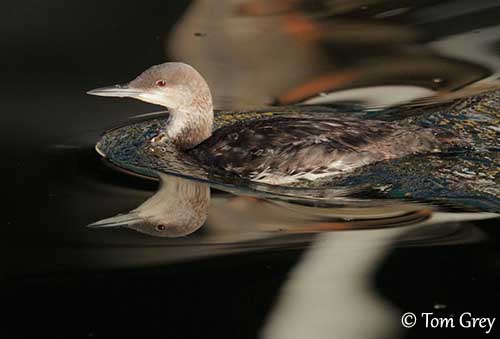
or Pacific Diver
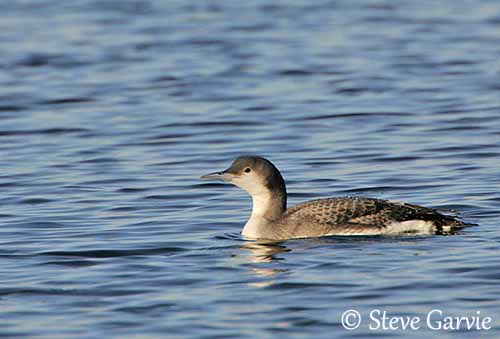
or Arctic Loon
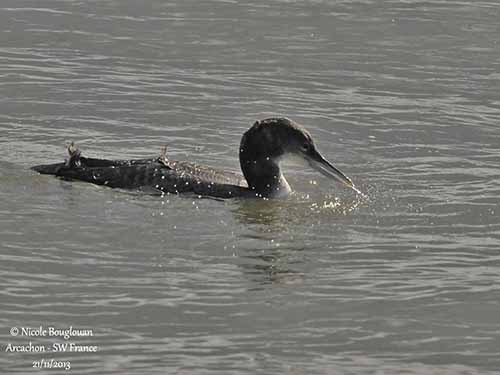
Loons or Divers are good fliers, and can fly over long distances. They have long migration, over land or water, at great heights. They need to run along the water surface for take-off, but once in the air, they fly with neck outstretched while the feet project beyond the tail. Head and feet are drooped below body-level.
They land also on water, with the webbed feet extended to skid along the surface while the wings are used for stopping on the water. However, the Red-throated Diver or Loon which is the lightest species, can take-off from land or alight on it.
The flight is swift and direct, performed with rapid wingbeats and usually quite high.
or Arctic Loon
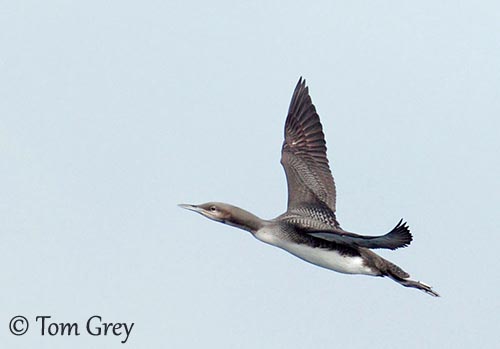
or Pacific Diver
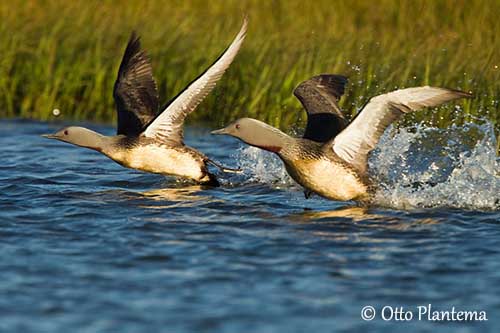
Divers or Loons are not currently considered to be threatened, but it is difficult to know the size of populations, as these birds breed in remote areas or rest at sea.
Human disturbances with recreational activities on lakes and rivers involve restricted breeding areas or wintering locations. Habitat loss is a threat, but the birds have adapted to reservoirs. Chemical pollution affects both coastal and inland waters, reducing the preys in these areas. The birds may be entangled in fishing nets and drown. Oil pollution is an important threat too.
Protection measures are active, with protection of breeding sites in Britain, USA and Scandinavia. Substitute nest-sites such as floating islets are used by Divers or Loons, especially in North America.
The result is very encouraging, as several populations have now recovered good levels.
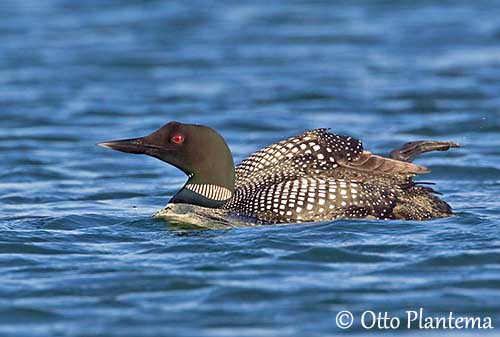
or Common Loon
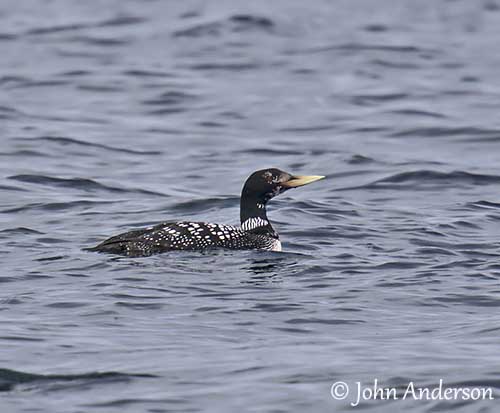
or Yellow-billed Loon
